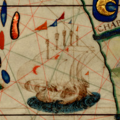Archivo:Javanese or Sundanese jong in China Sea, from Miller Atlas of 1519.png
Apariencia
Javanese_or_Sundanese_jong_in_China_Sea,_from_Miller_Atlas_of_1519.png (266 × 432 píxeles; tamaño de archivo: 284 kB; tipo MIME: image/png)
Historial del archivo
Haz clic sobre una fecha y hora para ver el archivo tal como apareció en ese momento.
| Fecha y hora | Miniatura | Dimensiones | Usuario | Comentario | |
|---|---|---|---|---|---|
| actual | 07:15 3 nov 2019 |  | 266 × 432 (284 kB) | Verosaurus | {{Information |description ={{en|1=Cropped portion of China Sea, showing 2 large ships, one is six-masted and the other one, being shown from the aft, showing 3 masted ship (there could be more since the sails obstructed the front masts). Since it's showed inaccuracies with the description of Malay junk of the time, the image is clearly an attempt to depict a large Malay junk.}} |date =1519 |source =Lopo Homem-Reineis Atlas or Miller Atlas |author =Lopo Homem, Pedro... |
Usos del archivo
La siguiente página usa este archivo:
Uso global del archivo
Las wikis siguientes utilizan este archivo:
- Uso en en.wikipedia.org
- Uso en fr.wikipedia.org
- Uso en id.wikipedia.org
- Uso en ms.wikipedia.org
- Uso en mt.wikipedia.org
- Uso en uk.wikipedia.org
- Uso en zh.wikipedia.org



